In-tents course management
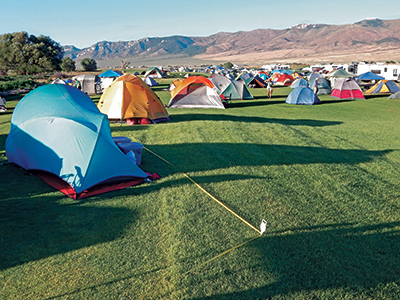 It’s a unique golf course that allows tent camping on its fairways. What kind of a management team actually
It’s a unique golf course that allows tent camping on its fairways. What kind of a management team actually
invites campers to bed down for a week on the course?
“I’m hanging my butt out,” acknowledged Randy Long, superintendent at White Pine County Golf Course, Ely, Nev., shortly before the campers arrived en masse. “I approached them and invited them to come.”
“Them” would be anywhere from 400 to 700 cavers, members of the National Speleological Society (NSS), who decided to hold their annual convention in the middle of nowhere, Nevada. They camp out, which means they want to put tent pegs, poles and pop-up campers on fairways. On the plus side, the NSS members — who are interested in science, exploration and enjoyment of caves — are an environmentally sensitive lot.
Still, it takes more guts to invite several hundred tent campers to set up on your fairways than it does to go up-and-over the tree line on a dogleg.
“Everything went really well,” Long, who also is general manager and head golf professional, said after the event. “There was no track or trace. They came in touting their footprint would not be very much. They were true to their word.”
Major impact
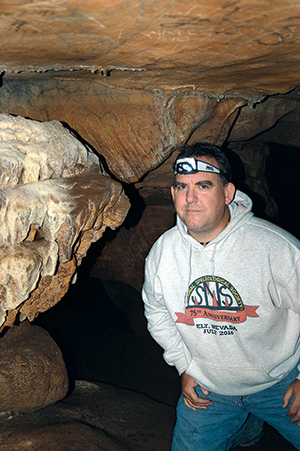
This past July, members of the National Speleological Society held their annual convention in Ely, Nev. Caver and event producer Matt Bowers (pictured) negotiated with White Pine County to rent half of its 18-hole rural golf course for the convention. The site featured a banquet hall tent, meeting rooms, security stations, medical facilities, entertainment stages and camping space for hundreds of cave explorers from around the world. The event delivered more than $15,000 in rental and supplementary income to the golf course.
A week after the event, Long was breathing much easier than he did the week before. “They were good stewards,” he said of the cavers. “They did what they said they would do.”
Long had two more things to be happy about. First, the revenue from the campers helped pay his seasonal help. Second, the camping fees — added to the men’s club donation and funds from Mt. Wheeler Power — put him over the top on the purchase of a much-needed Toro diesel greensmower from a course in Reno.
“It was a great infusion of cash,” Long said. Although open to the public, White Pine Golf Course has a schedule much more like an exclusive club. They see 10,000 to 11,000 rounds per year. In short, with greens fees in the $26 area, they are not rolling in cash.
“We are a small-budget course, enterprise funded,” Long said. “This would bring us some extra money.” He discussed the camper’s requirements with Matt Bowers, NSS convention chairman. “We wanted to be sure their footprint to be nominal,” Long said. Bowers assured him it would be.
“We are off the beaten path,” Long said. “We are isolated on the north end of town, surrounded by ranchland.” But not only that. The course in 2007 was named by Golf Digest as America’s most remote 18-hole course. It is 105 miles to the next nearest golf.
Looking for money
To build revenues, White Pine hosts rounds of archery golf, a sport not anticipated when the course was built in 1928. This is hunting country. The archers visit the course with live arrows, pay their greens and cart fees, and do their 18 holes.
So it wasn’t that big of a stretch for Long to figure that if he could charge each of 400 campers a “greens fee” of $26, he could have a significant impact on this year’s bottom line, maybe up to 10 percent. On top of that, the course’s design made it easy for him to isolate the camping and the big circus-style meeting tent around fairways 5, 6, 7 and 8, but still keep the back nine open for daily play.
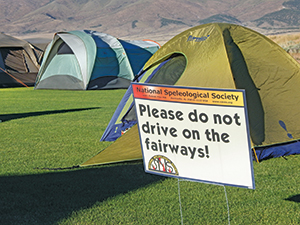
The cavers observed the rules of the course, and self-reported the few that were not.
A perfect loop road passes the camping area and allowed the cavers to get close to their tenting and still control who got in through the back gate to their area.
“I was at a meeting when Matt Bowers was talking about where the cavers could camp,” Long said. The cavers were hoping to find space on some BLM (Bureau of Land Management) land outside of town. It would have been a scattered bunch of campsites with uneven, stony, stick-covered tent sites.
“I told Bowers, ‘I’d like you to look at our golf course.’ I figured if we could get a greens fee out of all of them, it would be a bit of a windfall for us,” Long said.
In turn, the caver-campers got a nice, smooth, grassy, stone-free area to camp, and one close to town.
Campers loved the turf. “It is so nice to be able to walk around in bare feet,” said Scott Engel, a caver from Knoxville, Tenn. “You put up your tent and it is so soft underneath. You barely need any padding.”
There was absolutely no camping in the tee box areas or on the bentgrass greens. Those areas were watered throughout the week that the tents were on the fairways. A few weeks before the campers arrived, Long and his crew checked to be sure they would not be raining on anyone’s tent with their irrigation. Any spill-over areas were defined and declared off limits.
The campers respected all the restrictions. In fact, the only violations Long encountered were self-reported by the group. While there were some pets on site, there was no mess when the campers left.
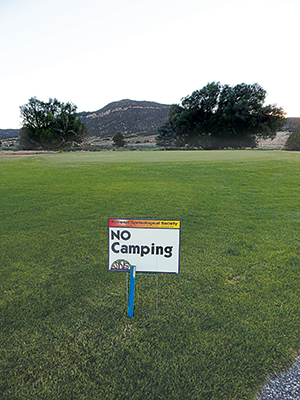
There was absolutely no camping in the tee box areas or on the bentgrass greens.
“We have enough room between the roughs and the fairways to handle 400 to 600 people,” Long figured. The roughs are crested wheat and other native grasses. Other areas are mainly Kentucky bluegrass, with some rye.
“We don’t know what to expect,” Long said a month before the event. Rather than being a detriment to regular golf, he saw some interest in daily players to do a round just to see what all the buzz was about with the campers.
He expected it would not all be dreamy. Leading up to the campout, Long let the fairway grass grow out.
“I expect some brown or yellow spots,” Long said. However, he didn’t see any more of a management problem with that than he has with the 50-gallon drums he puts out on the driving range for people to use as targets. The drums get moved every 10 days or so, and the yellow areas grow out after a mowing or two.
That said, he anticipated quick recovery. Since they are out of the Las Vegas-style desert at 6,400 feet, water is not a problem. They are not restrained by night watering. They get snow at White Pine and the greens are covered from November until April. The area this year had a wet spring, and the 6,843-yard, par 72 course was fit going into July. They are proud to tell you that 6,843 is 264 yards longer than America’s average 18 holes.
The cavers paid a $26 greens fee for the first 400 campers, with a reduced rate for 400-500 campers on the site. After 500, the rate went back to the full $26.
Campers like Engel and about 600 companions flooded the course. By mid-week, the turf was yellowing. More than showing wear, the lack of water and hot wind was turning the grass yellow. But, hey, in mid-July, with temperatures nearing 109 degrees, what would you expect?
By Friday, you almost could hear the grass cry for irrigation. By Saturday afternoon, there were no tents or campers to be seen. Recovery was under way.
Ten days after the event, Long said there were absolutely no agronomic problems with the turf. “There is nothing to notice that they were even here,” he said.
Ironically, the tents might have helped the course. “We lucked out,” Long said. “Those tents created a kind of greenhouse effect.”
During the week of the campout there was a steady 25- to 30-mph wind that sucked moisture out of the ground. Exposed areas were desiccated. “The moment you stop watering, the desert tries to reclaim the land right away,” Long said.
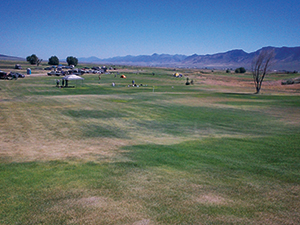
After the campout, it was easy to see where the tents were pitched. Those areas were still green, as opposed to the wind-dried brown patches.
After the campout, it was easy to see where the tents were pitched. Those areas were still green, as opposed to the wind-dried brown patches in between.
The only course areas needing extra TLC were No. 5 and No. 7. Both holes are on a shelf and fall away. “We needed some extra water there where the wind sucked it out of the ground,” Long said. Remember, he could not water while the campers were in the irrigation pattern.
“We’re hitting those zones hard,” Long said the week after the campout. “I expect they’ll recover in another five days.”
Long started his career in 1989, and the mid-July 2016 week-long campout surely is the most unique period in those 27 years. He says he would do the deal again. “It gave us a great little influx of cash,” he said. “They self-policed the area. They took care of the area just the way they said they would.”
Cave photo courtesy: Dave Bunnell, Under Earth Images, All other photos by curt Harler.








